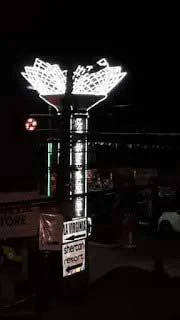Mataasnakahoy: on to the Golden Jubilee Year of 1982
[In this article: Mataasnakahoy Batangas, history of Mataasnakahoy, kasaysayan ng Mataasnakahoy. Ceferino Capuchino, Florencio Landicho, Artemio Landicho, UNIDO Party, Laurels of Batangas, Ferdinand Marcos KBL, Mataasnakahoy 50th Jubilee Celebrations]
We resume our ongoing series on the history of the town of Mataasnakahoy in Batangas based on the 1998 narrative of Ceferino Capuchino1. This is the sixth installment. Readers who missed the earlier articles of the series may find these archived under the Community History section of the main menu at the top of this page.
Although Soriano Lubis passed on in the late seventies, among his legacies was comprehensive paving of barrio roads during his term as Mayor, with the help of Linda Templo and Saturnino Benedicto, both engineers at the Department of Highways; and Gregorio M. Templo and Jose Magpantay, both well-placed presumably in the governments of Batangas City and Lipa City, respectively.
Mataasnakahoy’s image as a progressive town, Capuchino wrote, became more enhanced in 1980 when Florencio Landicho and Isagani Laluna, both lawyers, were elected Mayor and Vice-Mayor, respectively. Their election further raised the town’s profile in the province because it was the first time that the local government leadership was in the hands of what he called “professionals2.”
Capuchino wrote that Landicho’s election was something of a great triumph for the political party UNIDO, which was bannered by the Laurels (of Tanauan) against (Ferdinand) Marcos’ and Governor Tony Leviste’s KBL3. Because of this triumph, Capuchino claimed, Mataasnakahoy became known throughout the entire province of Batangas, and this was supposedly something that also helped the Laurels become more known in their home province.
It was not only Landicho who was part of the UNIDO party. Five of the Municipal Council also belonged to the same party: Celso Landicho, Alfredo Matanguihan, Macario Maranan, Renato Inciong and Mateo Magpantay.
It was also fortuitous that Mataasnakahoy’s Golden Anniversary (50th) Foundation Anniversary celebrations should also fall in 1982 during the term of Landicho. The Municipal Council formed a special committee to select outstanding citizens of the town. Leading the committee was one Loreto Laqui, with the mayor as co-chair. Capuchino, the author of the narrative upon which this series of articles is based, was secretary of the Municipal Council and also helped the committee.
The awards were given on the 2nd of February 1980 at the Municipal Hall. Artemio Lobrin received a plaque of recognition for being selected Mataasnakahoy’s “Most Illustrious Son.” Lobrin was at the time the only citizen of the town to have ever been elected to the National Assembly as a representative of the 3rd District of Batangas.
Jose D. Dimayuga also received a plaque after being honored with the title “Son of the Town” while special plaques were also awarded to Antonio Mandigma, Candido Recinto and their council members for having been the pillars upon which the town was built. These were Juan T. Hernandez, Agapito Templo, Enrique Caraan and Segundo Paran.
More than a hundred medals with certificates were also awarded to veterans of the revolution along with heroes who fought in Bataan, Corregidor and other battles. Among the awardees were Comandante Antonio M. Mandigma, Capitan Julian Recinto, Segundo Paran, Candido Recinto, Agapito Templo, Fausto Templo, Primitivo Silva, Eduardo Silva, Nicolas Templo, Agustin Vergara, Toribio Subol, Emiliano Vergara, Emilio Recinto, Guillermo Recinto, Sotero Haplos, Gregorio Salazar, Rufino Gonzales, Celestino Laqui, Dionisio Maranan, Bonifacio Calingasan, Severino Macasaet, Segundo Montenegro, Andres Mandigma, Agapito Dimaandal, Agapito Lalamunan, Raymundo Inciong, Benito Inciong, Nicolas Sarmiento, Lorenzo Biscocho, Alejandro Matanguihan. Lauro Matanguihan and Placido Tapat.
Certificates were also awarded to doctors, lawyers, dentists, engineers, judges, priests, pilots, PMA graduates, clerks of court, pharmacists and accountants, along with prominent businessmen in the town.
Among these were Engr. Gregorio T. Matanguihan, Dr. Lauro Lobrin, Atty. Calixto P. Luna, Pacita C. Luna, Paciano Orense, Ponciano Vizconde, Fr. Edgardo Lubis, Dr. Evaristo Tapalla, Captain Nicomen Versoza, Dr. Segundo Magpantay, Quinton O. Magpantay, Fiscal Florencio F. Landicho and Atty. Ponciano Hernandez.
Another committee was also set up by Landicho’s government to plan and gather funds for the erection of a memorial arch that would serve as proof, Capuchino wrote, that the town did not shirk its responsibilities to celebrate the jubilee. However, as the jubilee approached, it was decided instead to put up a giant tree that would serve as a symbol of the town.
The town fiesta on the 3rd of January 1982 was the grandest of all celebrations in which eleven barrios joined, with several floats in a parade as well as three marching bands.
Regrettably, wrote Capuchino, to the entire town’s dismay, Mayor Landicho passed away the following May. He was replaced by the town Vice-Mayor Laluna, who saw out what remained of Landicho’s term.
2 The author Capuchino seemed to be of the opinion that the top positions in local government ought to be occupied by lawyers, hence the claim that the town’s profile was enhanced upon the election of these into the positions of Mayor and Vice-Mayor.
3 UNIDO was the United Nationalist Democratic Organization, “the main political multi-party electoral alliance of the traditional political opposition during the turbulent last years of Philippine President Ferdinand Marcos in the mid-1980s.” “United Nationalist Democratic Organization,” Wikipedia.

